Scandinavian vs Bolivian Community Comparison
COMPARE
Scandinavian
Bolivian
Social Comparison
Social Comparison
Scandinavians
Bolivians
7,944
SOCIAL INDEX
76.9/ 100
SOCIAL RATING
98th/ 347
SOCIAL RANK
8,880
SOCIAL INDEX
86.3/ 100
SOCIAL RATING
42nd/ 347
SOCIAL RANK
Bolivian Integration in Scandinavian Communities
The statistical analysis conducted on geographies consisting of 171,625,421 people shows a moderate positive correlation between the proportion of Bolivians within Scandinavian communities in the United States with a correlation coefficient (R) of 0.405. On average, for every 1% (one percent) increase in Scandinavians within a typical geography, there is an increase of 0.187% in Bolivians. To illustrate, in a geography comprising of 100,000 individuals, a rise of 1,000 Scandinavians corresponds to an increase of 186.9 Bolivians.
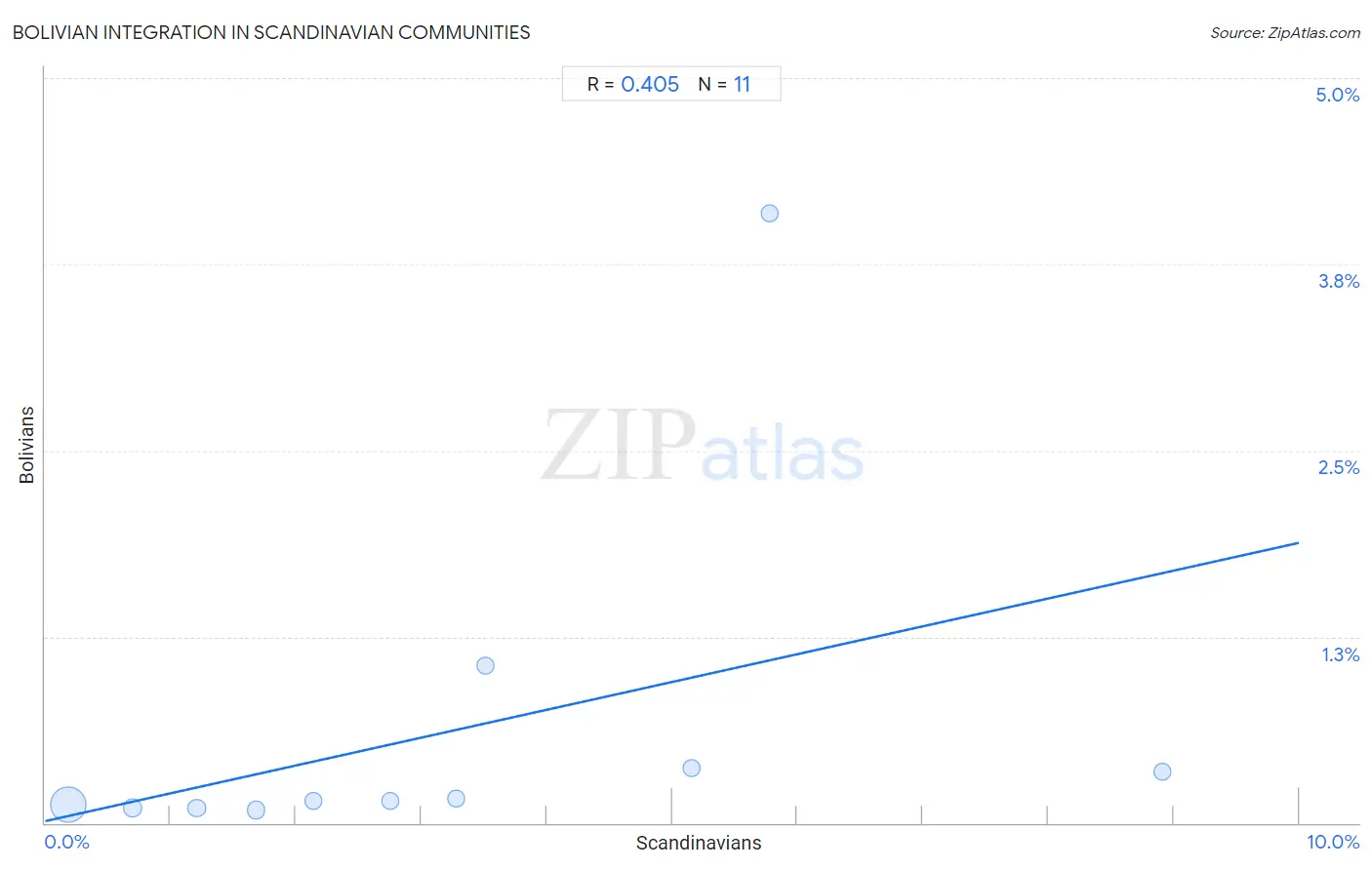
Scandinavian vs Bolivian Income
When considering income, the most significant differences between Scandinavian and Bolivian communities in the United States are seen in householder income over 65 years ($61,586 compared to $74,245, a difference of 20.6%), median household income ($86,073 compared to $102,195, a difference of 18.7%), and householder income ages 45 - 64 years ($102,969 compared to $118,871, a difference of 15.4%). Conversely, both communities are more comparable in terms of wage/income gap (29.1% compared to 26.8%, a difference of 8.6%), median male earnings ($55,527 compared to $61,066, a difference of 10.0%), and householder income under 25 years ($52,654 compared to $58,506, a difference of 11.1%).

| Income Metric | Scandinavian | Bolivian |
| Per Capita Income | Average $43,848 | Exceptional $49,526 |
| Median Family Income | Good $104,410 | Exceptional $119,479 |
| Median Household Income | Good $86,073 | Exceptional $102,195 |
| Median Earnings | Average $46,433 | Exceptional $52,005 |
| Median Male Earnings | Good $55,527 | Exceptional $61,066 |
| Median Female Earnings | Tragic $38,306 | Exceptional $43,445 |
| Householder Age | Under 25 years | Good $52,654 | Exceptional $58,506 |
| Householder Age | 25 - 44 years | Good $95,596 | Exceptional $109,372 |
| Householder Age | 45 - 64 years | Good $102,969 | Exceptional $118,871 |
| Householder Age | Over 65 years | Good $61,586 | Exceptional $74,245 |
| Wage/Income Gap | Tragic 29.1% | Tragic 26.8% |
Scandinavian vs Bolivian Poverty
When considering poverty, the most significant differences between Scandinavian and Bolivian communities in the United States are seen in single female poverty (21.1% compared to 17.9%, a difference of 17.6%), single male poverty (13.1% compared to 11.2%, a difference of 16.8%), and female poverty among 18-24 year olds (20.3% compared to 17.4%, a difference of 16.2%). Conversely, both communities are more comparable in terms of family poverty (7.6% compared to 7.5%, a difference of 1.0%), receiving food stamps (9.7% compared to 9.3%, a difference of 4.1%), and female poverty (12.1% compared to 11.5%, a difference of 5.7%).
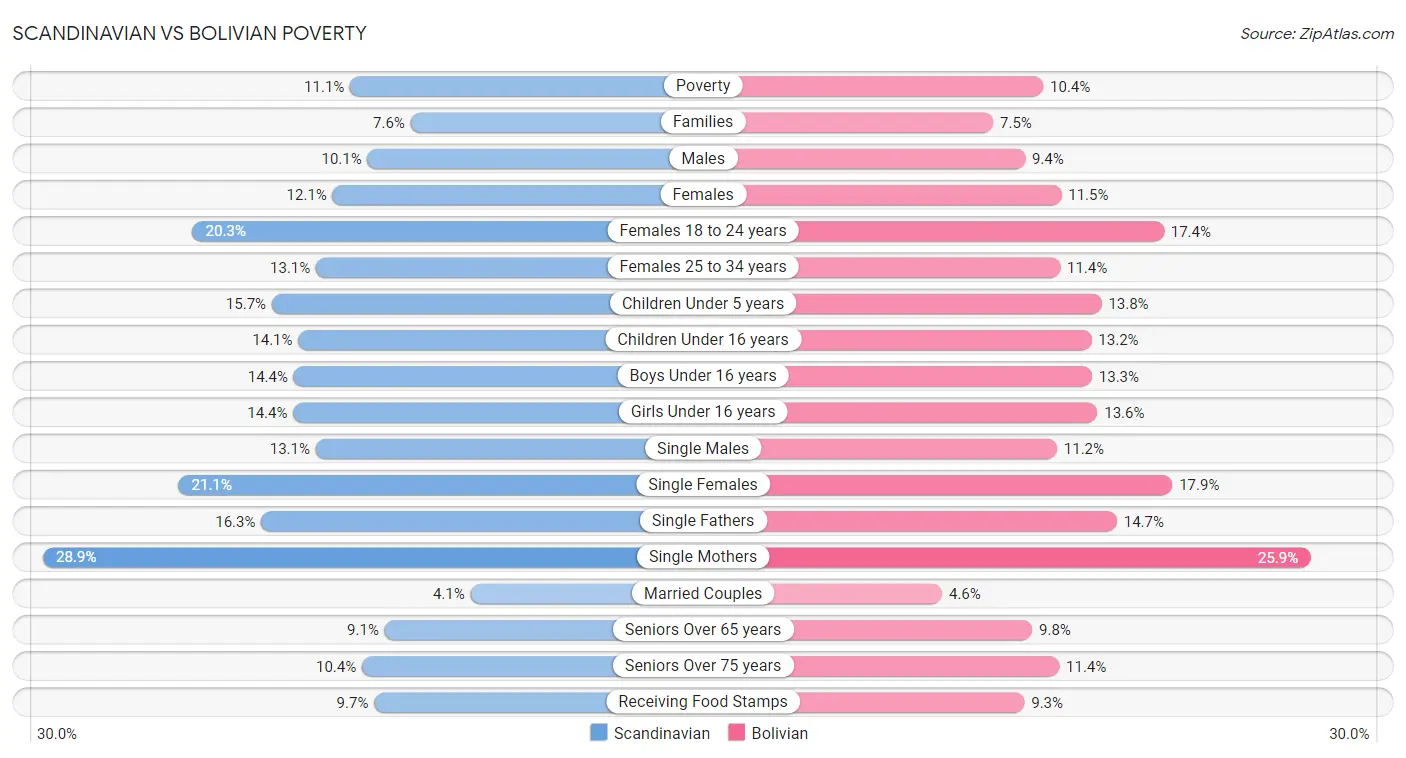
| Poverty Metric | Scandinavian | Bolivian |
| Poverty | Exceptional 11.1% | Exceptional 10.4% |
| Families | Exceptional 7.6% | Exceptional 7.5% |
| Males | Exceptional 10.1% | Exceptional 9.4% |
| Females | Exceptional 12.1% | Exceptional 11.5% |
| Females 18 to 24 years | Fair 20.3% | Exceptional 17.4% |
| Females 25 to 34 years | Excellent 13.1% | Exceptional 11.4% |
| Children Under 5 years | Exceptional 15.7% | Exceptional 13.8% |
| Children Under 16 years | Exceptional 14.1% | Exceptional 13.2% |
| Boys Under 16 years | Exceptional 14.4% | Exceptional 13.3% |
| Girls Under 16 years | Exceptional 14.4% | Exceptional 13.6% |
| Single Males | Poor 13.1% | Exceptional 11.2% |
| Single Females | Average 21.1% | Exceptional 17.9% |
| Single Fathers | Average 16.3% | Exceptional 14.7% |
| Single Mothers | Good 28.9% | Exceptional 25.9% |
| Married Couples | Exceptional 4.1% | Exceptional 4.6% |
| Seniors Over 65 years | Exceptional 9.1% | Exceptional 9.8% |
| Seniors Over 75 years | Exceptional 10.4% | Exceptional 11.4% |
| Receiving Food Stamps | Exceptional 9.7% | Exceptional 9.3% |
Scandinavian vs Bolivian Unemployment
When considering unemployment, the most significant differences between Scandinavian and Bolivian communities in the United States are seen in unemployment among seniors over 75 years (9.7% compared to 8.0%, a difference of 22.1%), unemployment among ages 16 to 19 years (15.4% compared to 17.3%, a difference of 11.9%), and female unemployment (4.6% compared to 5.0%, a difference of 9.1%). Conversely, both communities are more comparable in terms of unemployment among ages 65 to 74 years (5.2% compared to 5.1%, a difference of 0.16%), unemployment among women with children ages 6 to 17 years (8.6% compared to 8.5%, a difference of 0.16%), and male unemployment (4.7% compared to 4.7%, a difference of 0.29%).
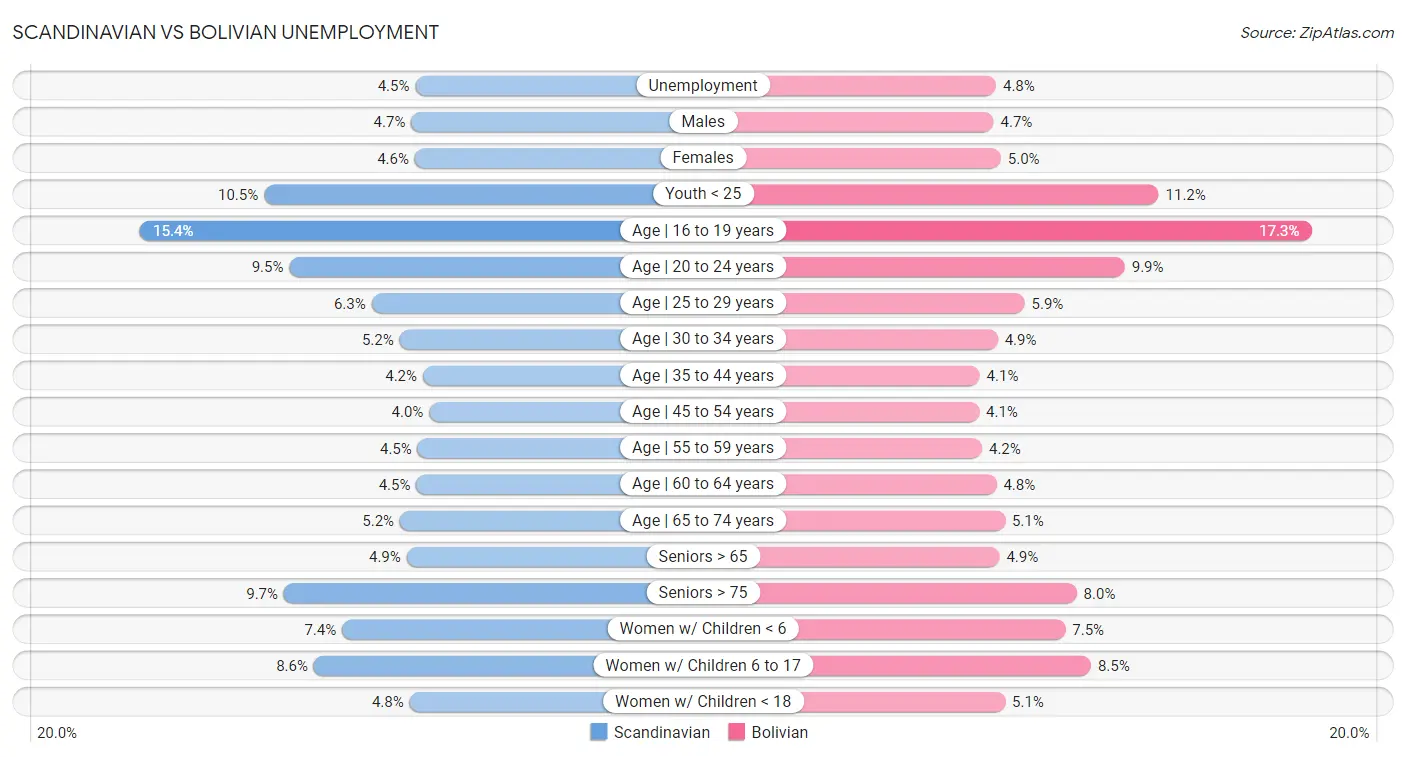
| Unemployment Metric | Scandinavian | Bolivian |
| Unemployment | Exceptional 4.5% | Exceptional 4.8% |
| Males | Exceptional 4.7% | Exceptional 4.7% |
| Females | Exceptional 4.6% | Exceptional 5.0% |
| Youth < 25 | Exceptional 10.5% | Exceptional 11.2% |
| Age | 16 to 19 years | Exceptional 15.4% | Excellent 17.3% |
| Age | 20 to 24 years | Exceptional 9.5% | Exceptional 9.9% |
| Age | 25 to 29 years | Exceptional 6.3% | Exceptional 5.9% |
| Age | 30 to 34 years | Exceptional 5.2% | Exceptional 4.9% |
| Age | 35 to 44 years | Exceptional 4.2% | Exceptional 4.1% |
| Age | 45 to 54 years | Exceptional 4.0% | Exceptional 4.1% |
| Age | 55 to 59 years | Exceptional 4.5% | Exceptional 4.2% |
| Age | 60 to 64 years | Exceptional 4.5% | Good 4.8% |
| Age | 65 to 74 years | Exceptional 5.2% | Exceptional 5.1% |
| Seniors > 65 | Exceptional 4.9% | Exceptional 4.9% |
| Seniors > 75 | Tragic 9.7% | Exceptional 8.0% |
| Women w/ Children < 6 | Excellent 7.4% | Good 7.5% |
| Women w/ Children 6 to 17 | Exceptional 8.6% | Exceptional 8.5% |
| Women w/ Children < 18 | Exceptional 4.8% | Exceptional 5.1% |
Scandinavian vs Bolivian Labor Participation
When considering labor participation, the most significant differences between Scandinavian and Bolivian communities in the United States are seen in in labor force | age 16-19 (43.6% compared to 36.0%, a difference of 21.1%), in labor force | age > 16 (65.0% compared to 68.2%, a difference of 4.9%), and in labor force | age 20-24 (78.5% compared to 75.2%, a difference of 4.4%). Conversely, both communities are more comparable in terms of in labor force | age 25-29 (84.9% compared to 86.1%, a difference of 1.4%), in labor force | age 30-34 (84.5% compared to 86.1%, a difference of 1.9%), and in labor force | age 35-44 (84.4% compared to 86.1%, a difference of 2.0%).

| Labor Participation Metric | Scandinavian | Bolivian |
| In Labor Force | Age > 16 | Fair 65.0% | Exceptional 68.2% |
| In Labor Force | Age 20-64 | Good 79.7% | Exceptional 81.7% |
| In Labor Force | Age 16-19 | Exceptional 43.6% | Fair 36.0% |
| In Labor Force | Age 20-24 | Exceptional 78.5% | Good 75.2% |
| In Labor Force | Age 25-29 | Excellent 84.9% | Exceptional 86.1% |
| In Labor Force | Age 30-34 | Fair 84.5% | Exceptional 86.1% |
| In Labor Force | Age 35-44 | Average 84.4% | Exceptional 86.1% |
| In Labor Force | Age 45-54 | Good 83.0% | Exceptional 84.9% |
Scandinavian vs Bolivian Family Structure
When considering family structure, the most significant differences between Scandinavian and Bolivian communities in the United States are seen in divorced or separated (12.3% compared to 11.2%, a difference of 9.5%), family households with children (28.0% compared to 29.5%, a difference of 5.4%), and average family size (3.14 compared to 3.29, a difference of 4.7%). Conversely, both communities are more comparable in terms of married-couple households (49.6% compared to 49.2%, a difference of 0.81%), single mother households (5.8% compared to 5.8%, a difference of 1.1%), and family households (65.0% compared to 66.5%, a difference of 2.2%).

| Family Structure Metric | Scandinavian | Bolivian |
| Family Households | Exceptional 65.0% | Exceptional 66.5% |
| Family Households with Children | Exceptional 28.0% | Exceptional 29.5% |
| Married-couple Households | Exceptional 49.6% | Exceptional 49.2% |
| Average Family Size | Tragic 3.14 | Exceptional 3.29 |
| Single Father Households | Fair 2.4% | Excellent 2.3% |
| Single Mother Households | Exceptional 5.8% | Exceptional 5.8% |
| Currently Married | Exceptional 49.5% | Exceptional 48.1% |
| Divorced or Separated | Poor 12.3% | Exceptional 11.2% |
| Births to Unmarried Women | Exceptional 29.8% | Exceptional 28.5% |
Scandinavian vs Bolivian Vehicle Availability
When considering vehicle availability, the most significant differences between Scandinavian and Bolivian communities in the United States are seen in no vehicles in household (7.0% compared to 8.6%, a difference of 22.4%), 4 or more vehicles in household (8.0% compared to 6.8%, a difference of 16.6%), and 3 or more vehicles in household (23.6% compared to 20.8%, a difference of 13.4%). Conversely, both communities are more comparable in terms of 1 or more vehicles in household (93.1% compared to 91.5%, a difference of 1.8%), 2 or more vehicles in household (62.1% compared to 58.3%, a difference of 6.4%), and 3 or more vehicles in household (23.6% compared to 20.8%, a difference of 13.4%).

| Vehicle Availability Metric | Scandinavian | Bolivian |
| No Vehicles Available | Exceptional 7.0% | Exceptional 8.6% |
| 1+ Vehicles Available | Exceptional 93.1% | Exceptional 91.5% |
| 2+ Vehicles Available | Exceptional 62.1% | Exceptional 58.3% |
| 3+ Vehicles Available | Exceptional 23.6% | Exceptional 20.8% |
| 4+ Vehicles Available | Exceptional 8.0% | Exceptional 6.8% |
Scandinavian vs Bolivian Education Level
When considering education level, the most significant differences between Scandinavian and Bolivian communities in the United States are seen in no schooling completed (1.5% compared to 2.4%, a difference of 59.2%), master's degree (14.4% compared to 19.3%, a difference of 34.2%), and professional degree (4.2% compared to 5.6%, a difference of 32.4%). Conversely, both communities are more comparable in terms of nursery school (98.6% compared to 97.6%, a difference of 0.96%), kindergarten (98.6% compared to 97.6%, a difference of 0.97%), and 1st grade (98.5% compared to 97.6%, a difference of 0.98%).
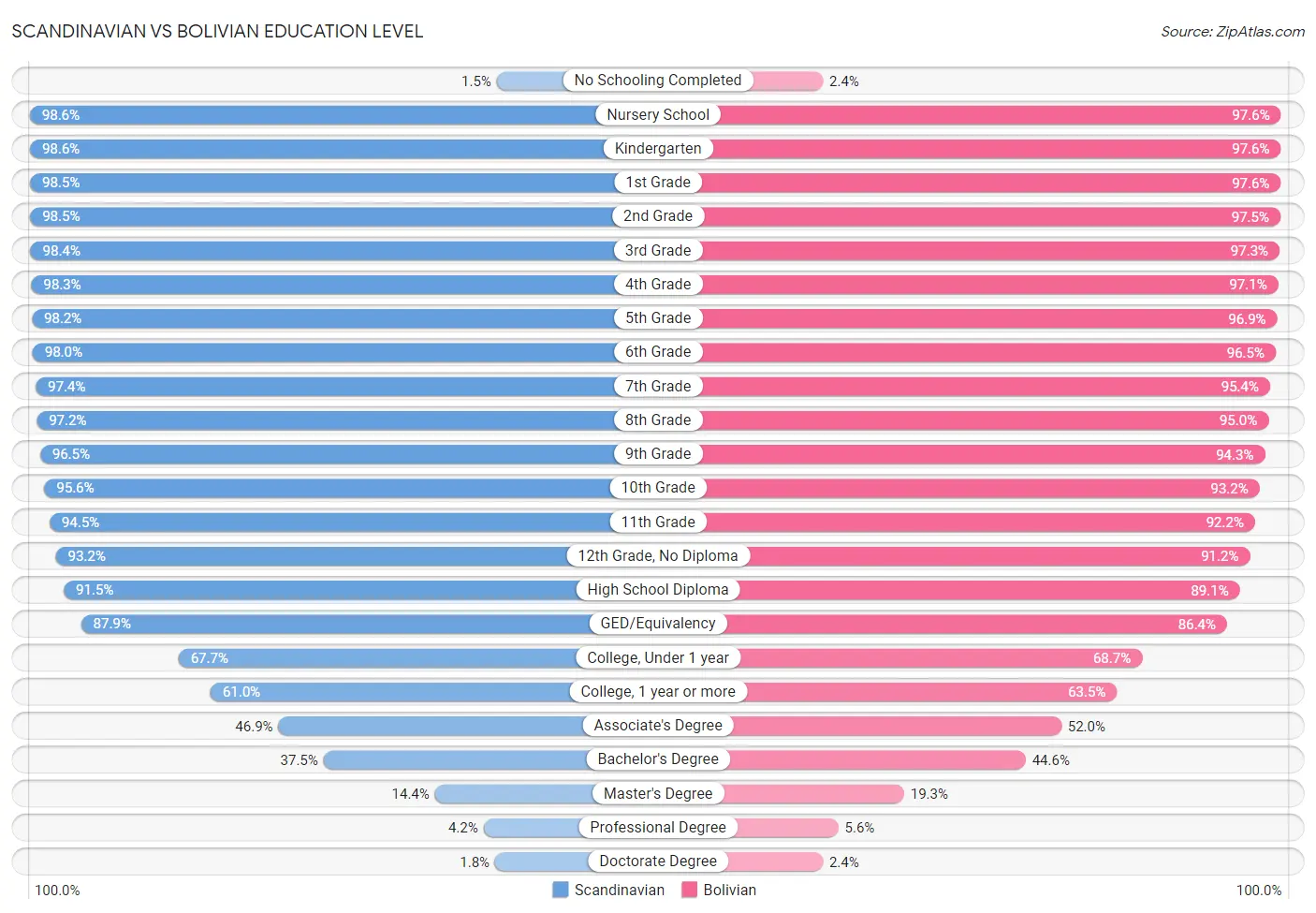
| Education Level Metric | Scandinavian | Bolivian |
| No Schooling Completed | Exceptional 1.5% | Tragic 2.4% |
| Nursery School | Exceptional 98.6% | Tragic 97.6% |
| Kindergarten | Exceptional 98.6% | Tragic 97.6% |
| 1st Grade | Exceptional 98.5% | Tragic 97.6% |
| 2nd Grade | Exceptional 98.5% | Tragic 97.5% |
| 3rd Grade | Exceptional 98.4% | Tragic 97.3% |
| 4th Grade | Exceptional 98.3% | Tragic 97.1% |
| 5th Grade | Exceptional 98.2% | Tragic 96.9% |
| 6th Grade | Exceptional 98.0% | Tragic 96.5% |
| 7th Grade | Exceptional 97.4% | Tragic 95.4% |
| 8th Grade | Exceptional 97.2% | Tragic 95.0% |
| 9th Grade | Exceptional 96.5% | Tragic 94.3% |
| 10th Grade | Exceptional 95.6% | Tragic 93.2% |
| 11th Grade | Exceptional 94.5% | Fair 92.2% |
| 12th Grade, No Diploma | Exceptional 93.2% | Average 91.2% |
| High School Diploma | Exceptional 91.5% | Average 89.1% |
| GED/Equivalency | Exceptional 87.9% | Excellent 86.4% |
| College, Under 1 year | Exceptional 67.7% | Exceptional 68.7% |
| College, 1 year or more | Excellent 61.0% | Exceptional 63.5% |
| Associate's Degree | Good 46.9% | Exceptional 52.0% |
| Bachelor's Degree | Average 37.5% | Exceptional 44.6% |
| Master's Degree | Fair 14.4% | Exceptional 19.3% |
| Professional Degree | Fair 4.2% | Exceptional 5.6% |
| Doctorate Degree | Average 1.8% | Exceptional 2.4% |
Scandinavian vs Bolivian Disability
When considering disability, the most significant differences between Scandinavian and Bolivian communities in the United States are seen in disability age under 5 (1.5% compared to 1.0%, a difference of 49.4%), hearing disability (3.6% compared to 2.6%, a difference of 39.2%), and disability age 35 to 64 (11.9% compared to 8.9%, a difference of 32.9%). Conversely, both communities are more comparable in terms of cognitive disability (16.9% compared to 16.5%, a difference of 2.9%), disability age over 75 (46.6% compared to 45.2%, a difference of 3.2%), and self-care disability (2.4% compared to 2.2%, a difference of 10.5%).
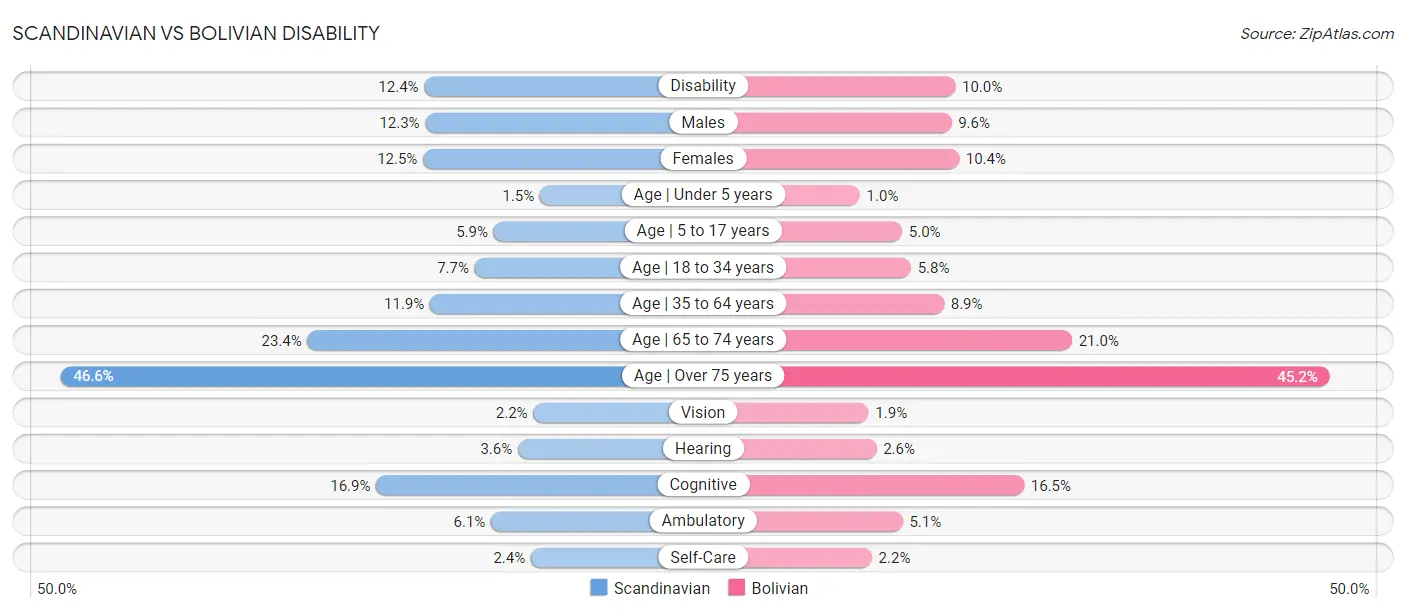
| Disability Metric | Scandinavian | Bolivian |
| Disability | Tragic 12.4% | Exceptional 10.0% |
| Males | Tragic 12.3% | Exceptional 9.6% |
| Females | Tragic 12.5% | Exceptional 10.4% |
| Age | Under 5 years | Tragic 1.5% | Exceptional 1.0% |
| Age | 5 to 17 years | Tragic 5.9% | Exceptional 5.0% |
| Age | 18 to 34 years | Tragic 7.7% | Exceptional 5.8% |
| Age | 35 to 64 years | Tragic 11.9% | Exceptional 8.9% |
| Age | 65 to 74 years | Average 23.4% | Exceptional 21.0% |
| Age | Over 75 years | Exceptional 46.6% | Exceptional 45.2% |
| Vision | Average 2.2% | Exceptional 1.9% |
| Hearing | Tragic 3.6% | Exceptional 2.6% |
| Cognitive | Exceptional 16.9% | Exceptional 16.5% |
| Ambulatory | Average 6.1% | Exceptional 5.1% |
| Self-Care | Exceptional 2.4% | Exceptional 2.2% |